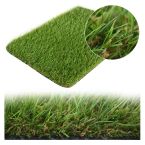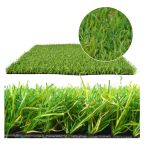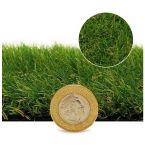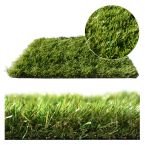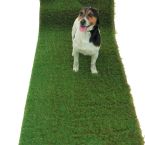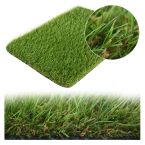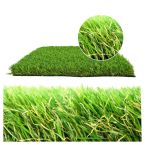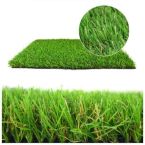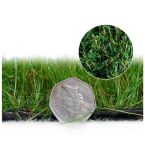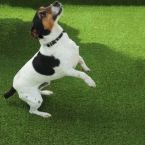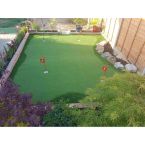TOP 25 QUERIES REGARDING ARTIFICIAL GRASS ANSWERED BY INDUSTRY EXPERTS: PART 1
Artificial grass industry has risen to fame like a forest fire. The recent years have seen a massive surge in its growth. A lot of homeowners have started installing it in their front gardens and back junkyards.
It’s the simplicity that appeals to the deepest of hearts but behind what you see, is a tremendous amount of work done. A comprehensive groundwork, tons of ingredients used as infill, complex drainage structure beneath to provide appropriate channeling of water, and world-class workmanship to get the job done with perfection.

The entire project comprises of hundreds of different big and small aspects; all of which has to go with precise supervision to achieve the desired goals.
With all these on the cards, homeowners will definitely have millions of queries going around in their heads. Let’s have a look at the top 25 questions with their answers from the industry experts.
1. Synthetic grass: how is it made
You will be surprised to know that behind the natural-looking fake grass, it is the plastic that is combined with green pellets to hold the colors and further treated with UV resistant additives to protect from direct sunlight and its adverse effects.
The plastic is melted and extruded through the perforated steel plate. The strands are then dumped into the trough of water used to solidify the synthetic grass mixture. There is a machine used to pull the strands through a large pulley and keep them separated before they are sent to the rollers which will stretch the strands until it achieves a similar look of that of natural grass blades. The grass strands are held on a spool. Once the spool is completely occupied, it is then mixed and woven with different colored strands to form multiple synthetic yarns.
Synthetic sheeting is merged with mesh fabric which is then traveled through a tube to the tufting machine. This machine is a giant sewing machine with around 200 needles to hook the yarn to the sheet (backing). During the tufting process, the yarns are cut at the ends with a knife placed underneath the machine. This helps them look similar to the natural grass blades. The sheet is now moved to the next station where adhesive will be applied at the backing.
Once the adhesive is dried in open and enclosed setting, it is then processed for drainage. Hot pins are used to burn holes in the sheet.
2. What material is used for its construction?
It’s been years of intense research and development to reach this “third-generation” synthetic grass as per the Synthetic Turf Council. Constant modification and transformation have lead to its evolution into high-quality synthetic grass which we know today as the best landscaping option.
Polyethylene, a common form of plastic is the key element behind the actual green blades of synthetic grass. They can be commonly found in items like bottles and plastic bags. The plastic comes in solid pellet form which is then heated along with the desired colored tones and UV resistant additives. While the grass blade is made using polyethylene, polypropylene is used to manufacture the thatch of the same grass.
3. What is a “denier” and why is it so important to know when you are considering to buying fake synthetic grass?
A denier is the measurement of the density of turf’s fibre. By definition, a denier is a weight per unit length (linear density) measure of a continuous filament or yarn. It expresses weight in grams of nine thousand meters length of the material.
An important point to extract for lay man’s understanding _ the lower the denier number, finer the material; and higher the denier number, coarser the material would be. In many countries, Tex system is used to measure the density of the fibre. One denier is equals to 1/9th of a tex or 10/9th of decitex.
4. What is “face weight” and what it means to you?
The face weight of your grass is the actual weight of the fibres excluding the weight of the backing. It is a key element for you to determine the worth of your grass. You can contemplate the pricing of the grass keeping in mind this ‘face weight’ aspect.
A common perception here is the heavier the product’s face weight would be, the higher the grass will cost you.
5. You should consider the drainage rate of the grass. Why does it matters and how it can help to achieve a beautiful yet practical lawn?
Drainage is one of the most important elements of your outdoor living and of paramount importance when it comes to providing practicality to synthetic grass.
Drainage is a network of holes designed strategically and with precise measurement to allow the water to percolate through the backing of the turf into the ground layer and then the water table.
It is of immense value as the last thing you want in your beautiful outdoor space is the water logging. This not only leads to unpleasant visuals, but can also entice mosquitoes and insects. A good drainage system can make cleaning sessions really quick.
With holes that measure ½ a centime in diameter, the drainage rate can be equivalent to more than 30 inches per hour per square yard.
6. Galvanized vs. Non-Galvanized Nail _ which is a better option while installation?
Well, sometimes rusted iron can be of better help than the non-rusted one. At least, it is the case with the synthetic grass installations.
Galvanized nails come with a protective layer of zinc oxide which prevents them from rusting. While for installation purposes, installers use non-galvanized nails as they don’t have any protected layer and will rust over the period of time which benefits the purpose.
Once the nails are rusted, they swell in size which further helps them to keep the turf tucked in to the ground for good.
7. What is a “thatch” and how does it make a difference to the synthetic grass?
In the simplest of words, a thatch is a brown fleck at the root zone of the grass blade which is typically a layer to help recover the grass strands while adding a more natural feel to the grass.
When it was invented, nobody knew that it would go such a long way and will prove to be such an asset for the grass industry. The addition of synthetic thatch to the synthetic grass has elevated the overall look and feel of the grass.
The thatch layer is made from polypropylene, polyethylene or nylon which helps in recovering the synthetic grass blade.
8. Turf Binds: Why is it so important for pre-buying consideration?
It is again an important technical aspect which gives you a more valuable insight of the turf you are going to get installed in your front or back garden. This in addition to other aspects will help you determine the worth of your turf.
To be more precise, this deals with the durability of your turf and how long it can retain the fibre (filaments) strands from getting pulled off the backing.
Technically, it is the force (measured in pounds) required to pull a turf from the backing. Also, known as ‘tuft lock’, an ideal grass should have 10+ pounds or more force to pull the filament from the backing.
The grass manufacturing process also requires a step where the backing is coated with adhesives to make it strong and secure for the synthetic grass. The coated backing is majorly comprised of urethane or a latex material.
9. UV Resistance: How is your synthetic grass made to sustain in direct sunlight without fading its charm out?

Ultimately, it is one of the critical business points and synthetic grass industry couldn’t have made to fame without it. It is the building block of its success story. Synthetic grass is nothing if it cannot sustain the harmful direct sunlight without causing any damage to the turf.
The synthetic turf comes with built-in UV inhibitors. These inhibitors translate into an amazing feature which allows the grass to hold its colour for years to come. They wouldn’t fade away in the most severe and harsh conditions. They will sustain in the sunniest conditions and will remain fresh and green for years to come.
These UV additives are specially designed to last for 10 to 15 years so you don’t need to worry about losing their colour or charm any time soon in the future.
If you want to explore few of the best artificial grass ranges in UK, click here.
10. Synthetic Grass is environment friendly. How they help in building a better tomorrow and a better world for our coming generation?
Synthetic grass, for many a reasons is an eco-friendly alternative to the natural greenery. There are a lot of pressing environmental concerns and synthetic grass addresses few of them quiet efficiently.
It’s been decades that we are using artificial grass as an alternate option to natural greenery. They have been serving the purpose with great functionality and practicality. And it’s not just the visual appeal and the functionality, they have aided to the multiple aspects of today’s environmental concerns as well.
a. Conservation of water resource: With uncommon distribution of water resource throughout the world, the concerns of water resource has been on the alarming stage. A lot of states across the globe are facing drought like situations with limited access to it. The rationing of water resource (one of the basic requisites to support life) is unfortunate. The use of synthetic grass comes with a great aspect that they don’t require water for its maintenance. You don’t need to water it to keep it fresh and green. This saves trillions of gallons of water every year. (Image hint: showcase the comparison between the natural greenery and the artificial greenery with water resource as the focal point, try to show how the saving of water can lead to a better world)
b. The use of pesticides has severe side effects: Though its usage in natural greenery is required to get rid of annoying bugs from plants and grass, but it has severe negative side as well. It may seep through to the water table and infiltrate it making it harmful and contagious. As per the Cancer Research Centre – UK, studies have indicated that the use of pesticides can be linked to cancers such as leukaemia, brain tumours, breast and prostate cancer.
c. Most notable of all _ Carbon Emissions: It is one of the most disastrous and pressing environmental concerns. The increase in carbon emissions has lead to the ozone layer depletion causing the harmful ultraviolet rays enter our atmosphere. Gas powered lawn mowers account for a descent percentage in carbon emissions every year. On the contrary, synthetic turf requires minimum or no use of such equipments and thus helping the environment to sustain.
This man-made synthetic turf is a great alternative with amazing environmental advantages over its natural counterpart.
11. What accessory to opt for binding the grass? Seaming tape or nails; which is a better option?
For binding purpose, it is necessary to decide which option to go for amongst the mentioned two _ a seaming tape or nails. Most professionals will prefer to go for nails and staples for majority of landscapes as the seams are easier to handle and manipulate as compared to the alternative sticky option of glue and seaming tape.
However, for larger installations like playgrounds and sports fields, seaming tape is a better option as these projects s will potentially have a high activity on the ground which is why seaming tape is a better choice here.
Remember though, for fastening the edges, you will still require nails and staples.
12. How to clean artificial grass? Why is it necessary and when to do it?
Now that you have got rid of lawn mowers, and you don’t need to mow or trim your grass anymore, so you might have gone out of practice of maintaining your lawn.
Though artificial grass is known for no or minimum maintenance still you will need to clean it to get rid of any debris collected. Here we are with easy cleaning tips to help you with your garden _
a. Some of the experts and homeowners believe that sometimes it’s good to keep your lawn covered with leaves and debris as they make your lawn appear more natural. But it is critical to decide when it’s necessary to clear them as the debris may start to decompose which is not good for your garden. Simpler tools like a carpet rake and leaf blower can do the job for you efficiently. Once a week cleaning approach should do the trick for you if it’s not a high activity zone.
b. There may be certain areas in your garden with flat grass blades due to high traffic and heavy foot fall. Try using brush in the opposite direction to help the grass stand up right.
Click here to read the Part 2 where we will discuss about cleaning tips for pets, the durability and how long is it going to last, turf infill, how to deal with stains, mold, bacteria and weed growth, flammability, turf backing, what to consider for pavers, walkers and driveways, warranty and many more.
Also, if you are looking for good options for Rugs, Carpets, and Vinyl Flooring please click below to visit:

